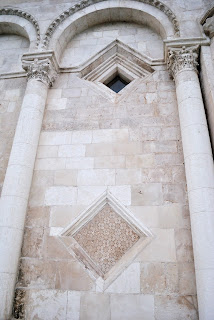It was 7 pm and the sky was still bright.
Before arriving in Manfredonia, coming from Zapponeta, I passed by the archaeological park of Siponto.
The park includes the basilica di Santa Maria Maggiore di Siponto (11th century) and the ruins of a basilica of the Early Middle Ages (4th century).
The first one is a magnificent example of Romanico Pugliese of which I am going to write about later.
Concerning the oldest basilica, we have inherited ruins and mosaics.

The archaeological park has just been renewed, thanks to the project called dove l'arte ricostruisce il tempo,
The project includes the permanent installation art of Edoardo Tresoldi, who has been commissioned to re-build the basilica through steel grids.
The project costed to the taxpayers 3.5 millions euro (POIn)
Talking about the Edoardo Tresoldi's installation art, Simone Pallotta says: "The Edoardo Tresoldi's project (Milan, 1987) is based upon the desire to portray the relationship between man and surrounding space".
"Tresoldi focuses on the idea of an architecture not as a solid mass but a structure which includes the landscape as an actual part of itself" he continues.
I have to confess that being within the installation is breathtaking.
According to the artist, this is the biggest installation art of steel ever made in the world.
Since the inauguration held on the 11th of March, the installation is attracting so many tourists, Italian and foreigner.
However, some art critics argue that the installation should be removed.
Why?
Teodoro De Giorgio advises that there are no documents which prove that the original church has the shape forged by Edoardo Tresoldi.
In addition, the installation has been fixed on the ground, where fragile ruins and mosaics might have been damaged.

"the installation is bulky" the art critic argues "therefore, the chance of reading the archaeological contest has been jeopardised".
The critic points the finger at Soprintendenza per i beni archeologici della Puglia, run by Luigi La Rocca, who has availed the project.
Finally, Teodoro De Giorgio remarks that it doesn't comply with the Italian Constitution (art. 9) which says "La Repubblica [...] tutela il paesaggio e il patrimonio storico e artistico della Nazione".
Therefore, the art critic hope for the removal of the installation.
Beside the Edoardo Tresoldi's work, there is the basilica of Santa Maria Maggiore di Siponto, which was consecrated on 1117.
I have always looked at this church superficially, never focusing on details.
This time, I slowly walk around the basilica and contemplate it.
According to Antonio De Tizio, its cubic shape symbolizes stability.
I'm mainly struck by two themes: firstly, the stiloforo lion sculpted beside the main entry. Secondly, the recurring motif of lozenges.
The lions seem having middle-Eastern traits.
Their eyes, big and well-defined, seem those of the Egyptian pharaoh.
Then, the lozenges, a motif which occur all around the church.
Lozenges symbolize female fertility.
According to the Dean Liprini's book, pathways of the sun (pp. 34), in Christian art lozenge symbolizes the Virgin Mary.
John North states in his book Stonehenge (pp. 504) "The lozenge is a symbol commonly found, from Ireland to Persia and beyond".
Actually, the oldest lozenge representation is the one discovered in South Africa at the Blomblos cave which dates back to 70.000 years ago
Templars, Teutonic knights and other crusade orders choose Apulia to settle down before departing for the holy land.
Nevertheless, if you are interested in finding out more about the Teutonic Order, then, you definitely must visit the San Leonardo abbey, few miles from Siponto, located between Manfredonia and Foggia.
San Leonardo is another story, though.
And I'm just realising that I should soon write something about it, because it's just so worth to be narrated.
Ciao











No comments:
Post a Comment